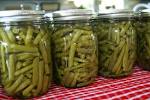La temporada de envasar alimentos ha comenzado y los agentes de Familia y Ciencias del Consumidor están programando clases para animar a las personas a seguir las directrices básicas de seguridad. La ![IMG_8931a[1]](https://bilingualopinions.wordpress.com/wp-content/uploads/2015/04/img_8931a1.jpg?w=150&h=95) primera de ellas es usar recetas y procesos que hayan sido científicamente aprobadas. El libro So Easy to Preserve es el recurso básico para envasar, congelar y deshidratar alimentos y tiene la ventaja de contar con un índice organizado. Empiece por el índice para determinar que métodos existen para el producto dado: si se encuentra en el índice, existe una recomendación, pero si no lo encuentra, no tiene una receta aprobada.
primera de ellas es usar recetas y procesos que hayan sido científicamente aprobadas. El libro So Easy to Preserve es el recurso básico para envasar, congelar y deshidratar alimentos y tiene la ventaja de contar con un índice organizado. Empiece por el índice para determinar que métodos existen para el producto dado: si se encuentra en el índice, existe una recomendación, pero si no lo encuentra, no tiene una receta aprobada.
Hay muchas fuentes de información para envasar en las que usted no debe confiar: sitios de internet, blogs, libros y jefes de cocina o celebridades. Usted debe evitar usar recetas viejas, incluso aquellas que han sido publicadas de nuevo ya que las recomendaciones de envase han cambiado con los años y se han actualizado con el avance de la ciencia. Recuerde, que su seguridad está en juego.
Debido a esto, usted debe ser cuidadoso al seguir el consejo de otras personas que envasan en casa, en especial de aquellas personas que han envasado por años o que lo hicieron cuando eran chicos, porque es posible que ellos hayan aprendido viejas formas de envase como: empacar o envasar sin procesar (open kettle), envasar con vapor, (steam canning), o colocar los frascos al revés y nunca han actualizado su conocimiento sobre el tema. Recuerde que solo porque “nadie ha muerto” al realizar estos métodos de envase quiere decir que nadie vaya a morir.
Una vez que haya decidido que receta hacer del libro So Easy to Preserve, es muy importante que siga algunos otros pasos para obtener un producto seguro:
- Debe seguir la receta y los procedimientos al pie de la letra. Si las instrucciones dicen pelar y cortar, usted debe pelar y cortar. Si dice cocinar por 30 minutos en frascos de pint (frascos de 16 onzas), usted debe cocinar en frascos de pint por 30 minutos. Envasar no es el momento de demostrar nuestros talentos culinarios. Por su seguridad, es importante no desviarse de la receta sin saltarse ningún paso del proceso. Después, cuando esté listo para usar el producto envasado, usted puede demostrar su creatividad culinaria.
- Los ingredientes que usted use para envasar necesitan ser de la mejor calidad, maduros pero no demasiado y nunca que hayan sido recogidos del suelo. Los métodos de conservación de alimentos no hacen que los alimentos mejoren, y los alimentos que están a punto de dañarse se dañarán más al conservarlos.
- Y en la cocina, los más importante es la limpieza. Limpie cuidadosamente y a fondo los alimentos y envases a usar y siempre trabaje en áreas limpias, con manos y utensilios limpios.
 Envasar es una manera divertida de conservar alimentos y es muy seguro se hace de manera correcta. Para leer más sobre envasar y conservar visite The National Center for Home Food Preservation http://nchfp.uga.edu/ Encontrara información sobre el libro So Easy to Preserve, cursos en el web, recetas y auto estudios.
Envasar es una manera divertida de conservar alimentos y es muy seguro se hace de manera correcta. Para leer más sobre envasar y conservar visite The National Center for Home Food Preservation http://nchfp.uga.edu/ Encontrara información sobre el libro So Easy to Preserve, cursos en el web, recetas y auto estudios.


![images[4]](https://bilingualopinions.wordpress.com/wp-content/uploads/2015/01/images4.jpg?w=150&h=74)
![salad-istock-TaylorLittle[1]](https://bilingualopinions.wordpress.com/wp-content/uploads/2014/07/salad-istock-taylorlittle1-e1404828132954.jpg?w=150&h=127)